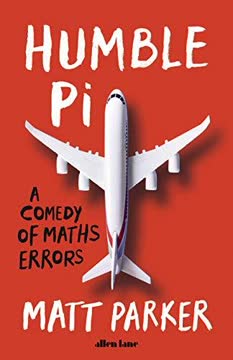Key Takeaways
1. Mathematical errors can have profound real-world consequences
Explaining why a joke is funny is a daunting task.
Math mistakes are ubiquitous. From everyday calculations to complex engineering projects, mathematical errors can lead to significant consequences. For example, in 1999, NASA lost a $125 million Mars Climate Orbiter due to a simple unit conversion error between metric and imperial systems. Similarly, a misplaced decimal point in a drug dosage calculation can result in a patient receiving a lethal dose.
These errors often stem from:
- Miscommunication
- Lack of attention to detail
- Overconfidence in calculations
- Failure to double-check results
The impact of such mistakes can range from minor inconveniences to catastrophic failures, highlighting the importance of mathematical accuracy in all aspects of life.
2. Small mistakes in calculations can lead to catastrophic results
All sorts of seemingly innocuous mathematical mistakes can have bizarre consequences.
Tiny errors can snowball. In complex systems, even a small mathematical error can propagate and amplify, leading to disastrous outcomes. The Tacoma Narrows Bridge collapse in 1940 is a prime example. A slight miscalculation in the bridge's design led to its spectacular failure in moderate winds.
Other examples include:
- The Millennium Bridge in London, which wobbled dangerously due to unforeseen resonance effects
- The Hubble Space Telescope's initial blurry images caused by a minute flaw in its mirror
- The Vasa warship that sank on its maiden voyage due to miscalculated stability
These cases underscore the need for rigorous checking and testing in engineering and scientific endeavors, as well as the importance of understanding the potential consequences of even the smallest errors.
3. Rounding and unit conversions are common sources of errors
The universe is 13,800 million years old. But if you're reading it three years after it was published, that does not mean that the universe is now 13,800,000,003 years old.
Precision matters. Rounding errors and unit conversion mistakes are among the most common mathematical blunders. These seemingly minor issues can lead to significant discrepancies, especially when dealing with large numbers or complex calculations.
Key points to remember:
- Rounding can introduce cumulative errors in iterative calculations
- Unit conversions require careful attention to maintain accuracy
- Significant figures should be considered when reporting results
- Different rounding conventions can lead to different outcomes
Examples of costly rounding and conversion errors include the Vancouver Stock Exchange's faulty index calculation and the "Gimli Glider" incident, where an Air Canada flight ran out of fuel mid-flight due to a confusion between pounds and kilograms.
4. Statistics and probability are often misunderstood and misused
Correlation is never enough to argue that one thing is causing another.
Misinterpreted data misleads. Statistics and probability are powerful tools, but they are frequently misunderstood and misapplied. This can lead to false conclusions and poor decision-making in fields ranging from medicine to finance.
Common pitfalls include:
- Confusing correlation with causation
- Misinterpreting p-values and statistical significance
- Failing to account for sampling biases
- Overlooking the importance of sample size
For instance, the "prosecutor's fallacy" has led to wrongful convictions by misrepresenting the probability of evidence. Similarly, misunderstanding of financial risk models contributed to the 2008 financial crisis. Proper statistical education and critical thinking are essential to avoid these errors.
5. Computer programming errors can cause major disasters
Programming is just formalized mathematical thought and processes.
Code can kill. As our world becomes increasingly dependent on software, programming errors can have far-reaching consequences. From minor glitches to catastrophic failures, these mistakes can affect millions of people and cost billions of dollars.
Notable examples include:
- The Ariane 5 rocket explosion due to a software error
- The Therac-25 radiation therapy machine overdoses
- The Y2K bug scare and its associated costs
Programming errors often arise from:
- Inadequate testing and quality assurance
- Reusing code without proper adaptation
- Failing to anticipate edge cases or unusual inputs
- Miscommunication between programmers and clients
To mitigate these risks, robust testing procedures, code reviews, and a culture of error reporting and correction are essential in software development.
6. Human intuition often fails when dealing with large numbers
As humans, we are not good at judging the size of large numbers.
Scale challenges perception. Our brains evolved to handle small numbers and linear relationships, making it difficult to intuitively grasp very large numbers or exponential growth. This limitation can lead to poor decision-making and misunderstanding of complex systems.
Examples of counterintuitive large numbers:
- A million seconds is about 11.5 days, while a billion seconds is nearly 32 years
- The difference between a million and a billion dollars is about $999 million
- There are more possible chess games than atoms in the observable universe
To overcome this limitation, we need to use tools and techniques like scientific notation, analogies, and visualizations to better understand and communicate large numbers and complex relationships.
7. Randomness is difficult to achieve and easy to misinterpret
Getting quality pseudorandom numbers continues to be a problem.
True randomness is elusive. Generating and interpreting random numbers is more challenging than it might seem. Computers, being deterministic machines, struggle to produce truly random numbers without external input. This has implications for cryptography, simulations, and statistical analysis.
Key points about randomness:
- Pseudorandom number generators can have hidden patterns
- Human attempts at randomness are often predictable
- Statistical tests for randomness can be fooled
- True randomness often requires physical processes (e.g., radioactive decay)
The misunderstanding of randomness can lead to errors in scientific studies, gambling fallacies, and vulnerabilities in computer security systems. Recognizing the limitations of our intuition about randomness is crucial for accurate analysis and decision-making.
8. Financial systems are vulnerable to mathematical oversights
Even auditors themselves are not immune.
Money magnifies mistakes. Financial systems rely heavily on complex mathematical models and algorithms. Errors in these systems can have far-reaching economic consequences, affecting individuals, companies, and entire economies.
Examples of financial math errors:
- The 2008 financial crisis, partly due to flawed risk models
- High-frequency trading glitches causing market volatility
- Accounting errors leading to misstated company valuations
- Currency conversion mistakes in international transactions
To mitigate these risks, financial institutions and regulators must:
- Implement robust error-checking systems
- Ensure transparency in financial models
- Conduct regular audits and stress tests
- Improve mathematical and financial literacy among professionals
9. Engineering failures often result from overlooked mathematical details
Sometimes the seemingly insignificant bits that get rounded off or averaged out are actually very important.
Details matter in design. Engineering projects involve complex calculations and models. Overlooking seemingly minor mathematical details can lead to catastrophic failures, costing lives and resources.
Notable engineering failures due to math errors:
- The Hyatt Regency walkway collapse
- The Sleipner A offshore platform sinking
- The Mars Climate Orbiter crash
Common sources of engineering math errors:
- Incorrect unit conversions
- Rounding errors in iterative calculations
- Misunderstanding of material properties
- Failure to account for all relevant variables
To prevent such failures, engineering practices must include rigorous peer review, extensive testing, and a culture that encourages questioning and double-checking of assumptions and calculations.
10. Data collection and analysis are prone to biases and misinterpretation
Even auditors themselves are not immune.
Bias skews results. The process of collecting and analyzing data is fraught with potential pitfalls that can lead to incorrect conclusions. Biases can creep in at every stage, from study design to data interpretation.
Common biases in data analysis:
- Selection bias in sampling
- Confirmation bias in interpreting results
- Publication bias in reporting findings
- Survivorship bias in historical data
To combat these issues:
- Use rigorous statistical methods
- Implement blind and double-blind studies when possible
- Encourage replication of important studies
- Foster a culture of transparency in data sharing and analysis
Recognizing and addressing these biases is crucial for producing reliable and actionable insights from data in fields ranging from scientific research to business analytics.
Last updated:
FAQ
What's Humble Pi: A Comedy of Maths Errors about?
- Exploring math mistakes: The book delves into real-world mathematical errors, illustrating their significant consequences.
- Humorous anecdotes: Author Matt Parker uses humor to make complex mathematical concepts accessible and entertaining.
- Real-life implications: Each chapter highlights the importance of mathematics in everyday life, from engineering to finance, and the far-reaching effects of errors.
Why should I read Humble Pi by Matt Parker?
- Engaging storytelling: Matt Parker combines humor with education, making it enjoyable for both math enthusiasts and those who typically shy away from the subject.
- Real-world relevance: The book illustrates how mathematical errors impact various fields, emphasizing the importance of accuracy in calculations and decision-making.
- Increased math appreciation: Readers gain a greater appreciation for mathematics and its societal role, understanding common pitfalls in mathematical reasoning.
What are the key takeaways of Humble Pi?
- Math is everywhere: Mathematics is integral to daily life, influencing technology, finance, and more.
- Mistakes are common: Everyone, including professionals, makes mistakes, which can lead to serious consequences.
- Learning from errors: The stories encourage readers to be more mindful and precise in their mathematical endeavors.
What are the best quotes from Humble Pi and what do they mean?
- "A million seconds from now is just shy of eleven days." This quote illustrates the difficulty humans have in comprehending large numbers.
- "You can’t count on it." This phrase reminds readers that even simple counting can lead to errors if not approached carefully.
- "Our human brains are simply not wired to be good at mathematics." This emphasizes the innate challenges people face with math, suggesting education and practice are essential.
What types of mathematical errors are discussed in Humble Pi?
- Engineering mistakes: Examples include the Millennium Bridge wobble and the 20 Fenchurch Street building's reflective glass issue.
- Statistical miscalculations: Misinterpretation of statistics can lead to wrongful convictions, as seen in a case involving flawed statistical evidence.
- Computer errors: Issues like the divide-by-zero error in computer systems illustrate how programming mistakes can have serious implications.
How does Humble Pi explain the importance of precision in mathematics?
- Real-world examples: Anecdotes demonstrate how small errors in calculations can lead to catastrophic outcomes, such as the Therac-25 radiation machine incident.
- Cautionary tales: Each story serves as a reminder of the need for precision and attention to detail in mathematical work.
- Encouraging mindfulness: The book advocates for a careful approach to mathematics, urging readers to double-check their work.
What is the significance of the title Humble Pi?
- Play on words: The title references the mathematical constant pi (π), symbolizing the complexity and unpredictability of mathematics.
- Emphasis on humility: "Humble" suggests that even confident mathematicians can make mistakes, highlighting the importance of humility.
- Connection to errors: The title encapsulates the theme of exploring mathematical errors and the lessons learned from them.
How does Humble Pi address the concept of probability?
- Human intuition vs. reality: Parker discusses how human intuition often fails in understanding probabilities, leading to misconceptions.
- Real-life examples: Anecdotes like the lottery illustrate how probability works in practice and how people misinterpret it.
- Encouraging critical thinking: Parker urges readers to think critically about probabilities and not rely solely on gut feelings.
How does Humble Pi illustrate the relationship between math and technology?
- Coding errors: Programming mistakes can lead to significant failures, such as the Knight Capital trading loss and the Ariane 5 rocket disaster.
- Randomness in computing: The book explores how computers generate random numbers and the challenges of achieving true randomness.
- Human error in tech: Human error is often the root cause of technological failures, highlighting the need for robust systems.
What are some notable examples of math errors discussed in Humble Pi?
- Ariane 5 Rocket Failure: A programming error caused the rocket to self-destruct shortly after launch due to a data type mismatch.
- Knight Capital's Trading Loss: A coding error led to a $461.1 million loss in a single day, illustrating financial devastation from small mistakes.
- Vancouver Stock Exchange Index: An error in calculation led to the index reporting a value half of what it should have been.
How does Humble Pi encourage a positive attitude towards mistakes?
- Embracing fallibility: Parker advocates for a culture that accepts mistakes as part of the learning process.
- Personal anecdotes: The author shares his own experiences with mathematical errors, making the message relatable.
- Promoting curiosity: By framing mistakes as opportunities for exploration, Parker inspires deeper engagement with mathematics.
What are the implications of math errors in finance, as discussed in Humble Pi?
- High-stakes environment: Even minor coding errors can lead to massive losses, as seen with Knight Capital.
- Impact on market stability: Errors in trading algorithms can disrupt market stability, leading to phenomena like the flash crash.
- Regulatory considerations: Parker emphasizes the need for oversight and accountability in the financial industry.
Review Summary
Humble Pi receives largely positive reviews for its entertaining exploration of mathematical errors in the real world. Readers appreciate Parker's humor, accessible writing style, and wide-ranging examples from engineering, computing, and everyday life. Many find the book both informative and amusing, praising its ability to engage even those who typically dislike math. Some criticisms include repetitiveness in later chapters and a lack of cohesion. Overall, reviewers recommend it as an enjoyable read that highlights the importance of mathematics in our daily lives.
Similar Books









Download PDF
Download EPUB
.epub digital book format is ideal for reading ebooks on phones, tablets, and e-readers.





